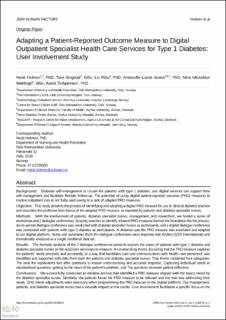Adapting a patient-reported outcome measure to digital Outpatient specialist health care services for type 1 diabetes: User involvement study
Holmen, Heidi; Singstad, Tone; Ribu, Lis; Lunde Jensen, Annesofie; Weldingh, Nina Mickelson; Torbjørnsen, Astrid
Peer reviewed, Journal article
Published version
Permanent lenke
https://hdl.handle.net/11250/3033098Utgivelsesdato
2022Metadata
Vis full innførselSamlinger
Originalversjon
10.2196/38678Sammendrag
Background:Diabetes self-management is crucial for patients with type 1 diabetes, and digital services can support their self-management and facilitate flexible follow-up. The potential of using digital patient-reported outcome (PRO) measures in routine outpatient care is not fully used owing to a lack of adapted PRO measures.
Objective:This study presents the process of identifying and adapting a digital PRO measure for use in clinical diabetes practice and describes the preferred item topics of the adapted PRO measure, as reported by patients and diabetes specialist nurses.
Methods:With the involvement of patients, diabetes specialist nurses, management, and researchers, we hosted a series of workshops and 2 dialogue conferences. Scoping searches to identify relevant PRO measures formed the foundation for the process. An in-person dialogue conference was conducted with diabetes specialist nurses as participants, and a digital dialogue conference was conducted with patients with type 1 diabetes as participants. A diabetes-specific PRO measure was translated and adapted to our digital platform. Notes and summaries from the dialogue conferences were imported into NVivo (QSR International) and thematically analyzed as a single combined data set.
Results:The thematic analysis of the 2 dialogue conferences aimed to explore the views of patients with type 1 diabetes and diabetes specialist nurses on the outcomes necessary to measure. An overarching theme, Ensuring that the PRO measure captures the patients’ needs precisely and accurately, in a way that facilitates care and communication with health care personnel, was identified and supported with data from both the patients and diabetes specialist nurses. This theme contained four categories: The need for explanatory text after questions to ensure understanding and accurate response, Capturing individual needs in standardized questions, getting to the heart of the patient’s problem, and The questions increase patient reflection.
Conclusions:We successfully conducted an iterative process that identified a PRO measure aligned with the topics raised by the diabetes specialist nurses. Similarly, the patients found the PRO measure to be relevant and one that was addressing their needs. Only minor adjustments were necessary when programming the PRO measure in the digital platform. Our management, patients, and diabetes specialist nurses had a valuable impact on the results. User involvement facilitated a specific focus on the clinical requests to be met by PRO measures and how they must be adapted to local and digital platforms. Overall, this has facilitated the current implementation of the adapted digital PRO measure.

